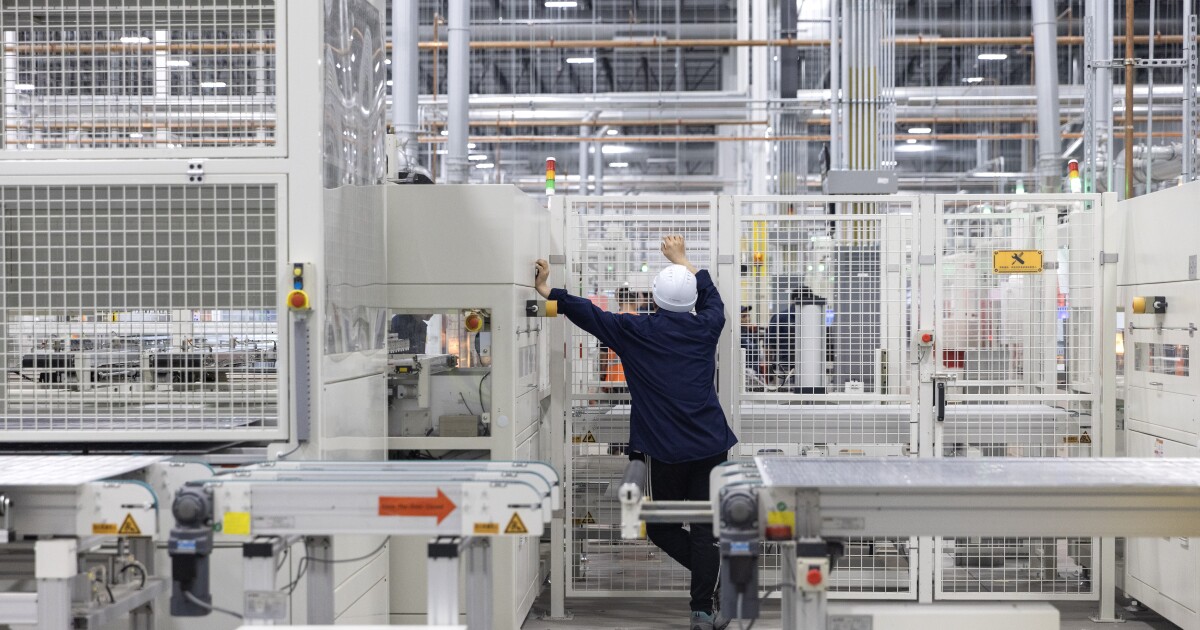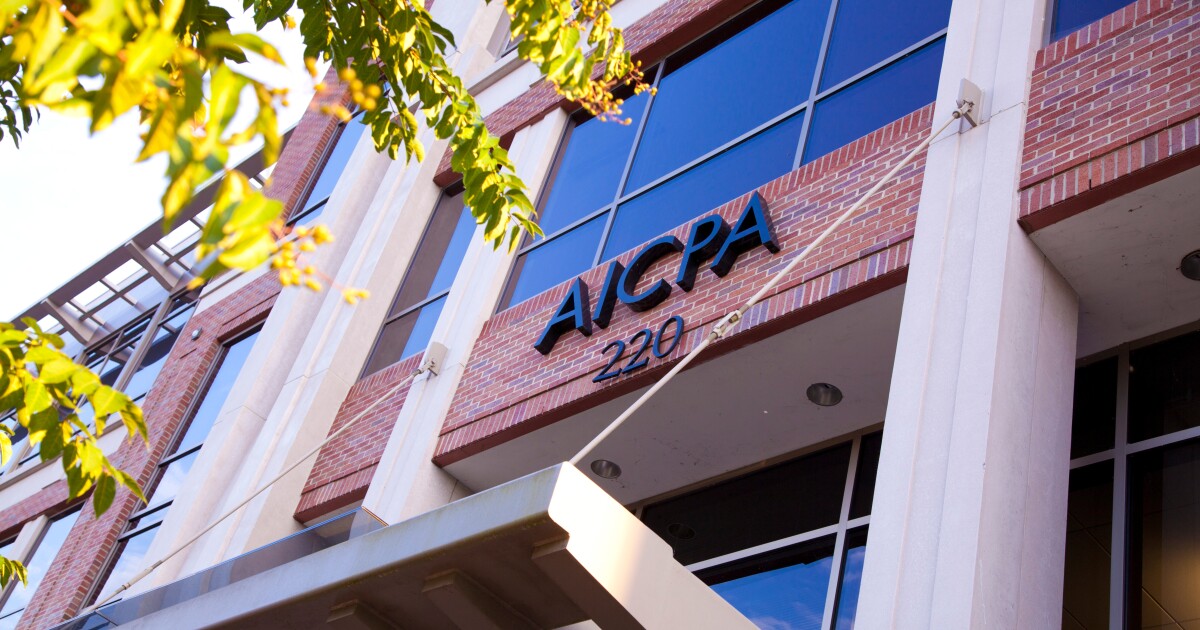Accounting
How American tax breaks brought a Chinese solar energy giant to Ohio
Published
7 months agoon


Nestled among the corn fields of Pataskala, Ohio, Illuminate USA’s sprawling new solar factory is buzzing. Hundreds of freshly hired local employees are hoisting pallets, soldering equipment and inspecting their work as sheets of glass are transformed into state-of-the-art photovoltaic panels. They’re collecting hourly wages that start at double the state minimum. The factory has also delivered contracts to area electricians and suppliers.
From the outside, these are the hallmarks of the 21st century clean energy manufacturing boom promised by the Biden administration, the result of sweeping incentives designed to restore national prowess in a market dominated by China.
In reality, what looks like a domestic triumph is also a win for America’s primary industrial and geopolitical rival. Invenergy, America’s biggest private renewable power developer, owns 51% of the plant. Longi Green Energy Technology Co., the Chinese solar giant, owns the other 49%, and it’s Longi’s panel-making expertise, technology and supply chain that are churning out tariff-free equipment for the U.S. market.
Inside the plant, signs in both English and Mandarin admonish workers to clean up trash. Machine displays also toggle between the two languages. More than 100 Chinese nationals are on site working alongside more than 1,000 American colleagues, and bridging the language barrier requires lots of hand gestures and smartphone-enabled translation. Illuminate says much of this is temporary, and most of the Chinese workers will leave once the Americans are up to speed.
But long after they return home, Longi will continue to profit. The joint venture benefits from millions in economic development incentives and federal tax credits for domestic clean energy manufacturing. For its part, Longi avoids anti-China tariffs and deepens its foothold in one of the
Companies based in or linked to China are replicating the strategy across the U.S. They are building or planning to build at least a dozen plants with 30 gigawatts of module-making capacity, according to a Bloomberg review of public statements, filings and other documentation. All told, the facilities would be able to supply roughly three-quarters of today’s U.S. panel needs. (BloombergNEF projects U.S. domestic demand for solar panels will be 45.5 gigawatts in 2024 and 50.4 gigawatts in 2025.)
American manufacturers are crying foul, saying these factories undermine their quest to build a domestic solar supply chain. Although other countries have taken advantage of the IRA’s subsidies, political objections have focused on Chinese investment. Bipartisan momentum is building in Congress to block China-backed firms from claiming tax credits for manufacturing anything central to the energy transition — a category that extends beyond solar panels to electric vehicles and batteries.
In Ohio, retired middle-school science teacher Eileen DeRolf has become an outspoken critic of Illuminate and the policies that brought it to Pataskala. She points to a 15-year tax abatement from the city and $4 million in incentives from a state economic development agency, to say nothing of the $350 million in potential annual tax subsidies from the Inflation Reduction Act.
“To me, this is betraying America, to allow an uneven playing field,” DeRolf said. “I happen to not particularly want our geopolitical No. 1 enemy to benefit off our economic system.”
Illuminate and its American and Chinese parent companies see it differently. They point to an influx of well-paying jobs and to a resurrection of manufacturing in a fast-growing sector of the economy.
“We’re a majority-owned American company,” said John Duer, Illuminate’s chief legal officer. “We have a minority partner based in China. We’re not a Chinese company trying to do business in the U.S.”
Executives at Invenergy and Longi had been talking about collaborating for years, but it took the Inflation Reduction Act — the 2022 law meant to jumpstart U.S. clean energy manufacturing — to spur them to action. Less than seven months after President Joe Biden signed the IRA, they
In addition to the tax credits Illuminate can claim for its U.S.-made panels, its parent companies reap significant benefits from the tie-up. Invenergy is the factory’s first and biggest customer, earning additional credits for using domestically produced components in its solar arrays. And Longi, like other Chinese panel-makers, brings advantages gained through decades of experience and generous support from Beijing.
In addition, the industry has been dogged by allegations that some suppliers
What no one disputes is that today Chinese companies dominate the market for solar panels and all of their component parts.
For environmental advocates, China’s cheap panels have been a boon, driving a more than 50-fold increase in emissions-free solar power generation globally since 2010. But to American rivals, something more nefarious was at work. They argued Chinese solar companies were selling their products below cost to unfairly corner the market, and trade authorities agreed, kicking off a cycle of tariffs meant to level the playing field.
Today, steep U.S. tariffs have effectively killed domestic demand for made-in-China solar panels. Companies, including Longi, first responded by shifting operations to other Asian nations, spurring another round of trade probes and enforcement. By producing panels in Ohio, Longi steps out of this game of
(The estimate is based on the average price in September for panels exported to the U.S. ($0.25 per watt), Longi’s share of Illuminate’s planned annual production capacity (5GW) and a potential combined antidumping and countervailing duty rate for Malaysian modules exported to the U.S. of 25%. Note: Any final
Combined with the incentives from the IRA, Longi and other panel-makers can “make huge profits,” said Yana Hryshko, chief solar analyst at consulting group Wood Mackenzie. After surviving two decades of industry turbulence, these “are not stupid companies,” she said. “They will not make a move without being confident.”
On a June Friday morning, job-seekers started to gather at the Perry County, Ohio, career center well before Illuminate’s recruitment event was scheduled to begin. Many of the plant’s workers come from outside Pataskala, including areas hit hard by the collapse of coal mining.
A job at the plant would mean a longer commute for Tricia Tilley, a 47-year-old janitor and church secretary. It would also nearly double her income and provide health insurance for her and her teenage son.
As for the company’s ties to China? “I know they’re from another country, but they’re here trying to put money into our country,” she said. “As long as it’s a good job and they’re paying everybody — keeping on the up-and-up — I don’t see any problem with it. Follow the rules like everybody else, we’re cool.”
Right now, Illuminate depends on the expertise of Chinese workers who’ve spent years handling specialized module-making machinery and brittle crystalline silicon cells. For many, it’s their first time outside of China, drawn by higher salaries and a sense of adventure.
“We’re here just to teach the American workers,” said Li, a production line technician who asked to be identified by her family name because she wasn’t authorized to speak to reporters. “When they can start a production line by themselves, there’ll be no need for us to be here anymore.”
Li’s days begin with a video chat around 5 a.m., a chance to talk with her children in China before a company shuttle takes her from suburban Columbus to the factory. Many of the Chinese workers at Illuminate work 12-hour shifts, six days a week, logging 60% more hours every month than the plant’s typical American employees.
Longi’s expats went through language training, though most rely on translators to communicate with their trainees. They also got a crash course in American culture, with advice to avoid commenting on race, skin color or body type. Li said her American colleagues have been kind.
“I hadn’t been out of China before. Now I get to come out and take a look,” she said. Li pegged her timeline at “two or three years. After that I’ll go back. Then I can say I’m a person who has been to the United States!”
Illuminate is leaning into its heartland identity. Its website touts its role “investing in Ohio” and “onshoring America’s supply chains.” It’s partnering with local high schools for a robotics challenge and also has sponsored the
DeRolf and other local skeptics deride these efforts as a charm offensive, albeit an effective one. It’s made it “ever so much more difficult to get this town and the people to pay attention to what we’ve got in that building,” DeRolf said.
Like DeRolf, activists in Mesquite, Texas, are taking aim at a $270 million plant that began producing panels late last year. Some 1,400 Texans now work at the factory owned by Canadian Solar Inc. — and while the company’s corporate headquarters are in Ontario, most of its directors and much of its manufacturing reside in China.
Foreign direct investment has always been critical to countries trying to build domestic industry. In the late 1990s, China, for its part, welcomed Western automakers, providing access to its growing market while learning from their decades of experience.
“Most of the companies that are building solar panels right now that have the know-how or skills are Chinese,” said Ilaria Mazzocco, a senior fellow at the Center for Strategic and International Studies. They also have well-established supply chains outside the U.S. At Illuminate, for example, panels are made with photovoltaic cells and glass from Malaysia and aluminum frames from Vietnam.
Many key materials aren’t yet produced domestically, and Illuminate says it’s actively working to expand its U.S. supply base.
The promise of the Inflation Reduction Act was that “you’re restoring the American industrial base,” said Nathan Picarsic, the founder of consulting group Horizon Advisory, which has investigated Chinese supply chain dominance and the use of forced labor. But as more Chinese-backed solar companies operate on U.S. soil, it betrays “the story that we’re telling ourselves about the manufacturing renaissance.”
The clash reverberates beyond solar to the fast-growing field of electric vehicles and battery manufacturing, also subsidized by the Inflation Reduction Act. In rural northwest Michigan, the town government is opposing an electric vehicle battery factory planned by a subsidiary of China’s
In Virginia, Governor Glenn Youngkin discouraged Ford Motor Co.’s interest in building an electric vehicle battery plant with China’s Contemporary Amperex Technology Co. Ltd. in the state, calling it a “
Licensing is one way the U.S. can tap Chinese manufacturing expertise and technical know-how while retaining more control over operations, said Mazzocco. Regardless, the issue is a flashpoint for politicians — and is fueling bipartisan efforts in Congress to bar companies with ties to China and other so-called “foreign entities of concern” from claiming the IRA’s manufacturing tax incentives. (It’s also a way lawmakers could try to offset spending in the next budget fight.) The Treasury Department could also move unilaterally to impose restrictions on what projects qualify for the credit.
Cory Ford, a school bus mechanic in the Pataskala area, doesn’t share his community’s embrace of the Illuminate plant. He doesn’t want U.S. taxpayer dollars to benefit Chinese industry; he’s also concerned that the firms could leave as quickly as they arrived. After all, Chinese companies have become expert at rapidly relocating in response to unfavorable tariffs or taxation.
“We’ve given so much in subsidies and government funding,” he said. “When that runs dry, how quickly is that building going to empty out?” And, he asks, what happens to the local American workers left behind?
Illuminate isn’t going anywhere, Duer said, even if Washington puts the manufacturing subsidies outside of reach: “We would adjust. Nothing is fatal. Nothing can’t be overcome. The fact of the matter is, we’re here to stay.”
You may like


The American Institute of CPAs is asking leaders of the Senate Finance Committee and the House Ways and Means Committee to make changes in the wide-ranging tax and spending legislation that was
In a
“While we support portions of the legislation, we do have significant concerns regarding several provisions in the bill, including one which threatens to severely limit the deductibility of state and local tax (SALT) by certain businesses,” wrote AICPA Tax Executive Committee chair Cheri Freeh in the letter. “This outcome is contrary to the intentions of the One Big Beautiful Bill Act, which is to strengthen small businesses and enhance small business relief.”
The AICPA urged lawmakers to retain entity-level deductibility of state and local taxes for all pass-through entities, strike the contingency fee provision, allow excess business loss carryforwards to offset business and nonbusiness income, and retain the deductibility of state and local taxes for all pass-through entities.
The proposal goes beyond accounting firms. According to the
The AICPA argued that SSTBs would be unfairly economically disadvantaged simply by existing as a certain type of business and the parity gap among SSTBs and non-SSTBs and C corporations would widen.
Under current tax law (and before the passage of the Tax Cuts and Jobs Act of 2017), it noted, C corporations could deduct SALT in determining their federal taxable income. Prior to the TCJA, owners of PTEs (and sole proprietorships that itemized deductions) were also allowed to deduct SALT on income earned by the PTE (or sole proprietorship).
“However, the TCJA placed a limitation on the individual SALT deduction,” Freeh wrote. “In response, 36 states (of the 41 that have a state income tax) enacted or proposed various approaches to mitigate the individual SALT limitation by shifting the SALT liability on PTE income from the owner to the PTE. This approach restored parity among businesses and was approved by the IRS through Notice 2020-75, by allowing PTEs to deduct PTE taxes paid to domestic jurisdictions in computing the entity’s federal non-separately stated income or loss. Under this approved approach, the PTE tax does not count against partners’/owners’ individual federal SALT deduction limit. Rather, the PTE pays the SALT, and the partners/owners fully deduct the amount of their distributive share of the state taxes paid by the PTE for federal income tax purposes.”
The AICPA pointed out that C corporations enjoy a number of advantages, including an unlimited SALT deduction, a 21% corporate tax rate, a lower tax rate on dividends for owners, and the ability for owners to defer income.
“However, many SSTBs are restricted from organizing as a C corporation, leaving them with no option to escape the harsh results of the SSTB distinction and limiting their SALT deduction,” said the letter. “In addition, non-SSTBs are entitled to an unfettered qualified business income (QBI) deduction under Internal Revenue Code section 199A, while SSTBs are subject to harsh limitations on their ability to claim a QBI deduction.”
The AICPA also believes the bill would add significant complexity and uncertainty for all pass-through entities, which would be required to perform complex calculations and analysis to determine if they are eligible for any SALT deduction. “To determine eligibility for state and local income taxes, non-SSTBs would need to perform a gross receipts calculation,” said the letter. “To determine eligibility for all other state and local taxes, pass-through entities would need to determine eligibility under the substitute payments provision (another complex set of calculations). Our laws should not discourage the formation of critical service-based businesses and, therefore, disincentivize professionals from entering such trades and businesses. Therefore, we urge Congress to allow all business entities, including SSTBs, to deduct state and local taxes paid or accrued in carrying on a trade or business.”
Tax professionals have been hearing about the problem from the Institute’s outreach campaign.
“The AICPA was making some noise about that provision and encouraging some grassroots lobbying in the industry around that provision, given its impact on accounting firms,” said Jess LeDonne, director of tax technical at the Bonadio Group. “It did survive on the House side. It is still in there, specifically meaning the nonqualifying businesses, including SSTBs. I will wait and see if some of those efforts from industry leaders in the AICPA maybe move the needle on the Senate side.”
Contingency fees
The AICPA also objects to another provision in the bill involving contingency fees affecting the tax profession. It would allow contingency fee arrangements for all tax preparation activities, including those involving the submission of an original tax return.
“The preparation of an original return on a contingent fee basis could be an incentive to prepare questionable returns, which would result in an open invitation to unscrupulous tax preparers to engage in fraudulent preparation activities that takes advantage of both the U.S. tax system and taxpayers,” said the AICPA. “Unknowing taxpayers would ultimately bear the cost of these fee arrangements, since they will have remitted the fee to the preparer, long before an assessment is made upon the examination of the return.”
The AICPA pointed out that contingent fee arrangements were associated with many of the abuses in the Employee Retention Credit program, in both original and amended return filings.
“Allowing contingent fee arrangements to be used in the preparation of the annual original income tax returns is an open invitation to abuse the tax system and leaves the IRS unable to sufficiently address this problem,” said the letter. “Congress should strike the contingent fee provision from the tax bill. If Congress wants to include the provision on contingency fees, we recommend that Congress provide that where contingent fees are permitted for amended returns and claims for refund, a paid return preparer is required to disclose that the return or claim is prepared under a contingent fee agreement. Disclosure of a contingent fee arrangement deters potential abuse, helps ensure the integrity of the tax preparation process, and ensures compliance with regulatory and ethical standards.”
Business loss carryforwards
The AICPA also called for allowing excess business loss carryforwards to offset business and nonbusiness income. It noted that the One Big Beautiful Bill Act amends Section 461(l)(2) of the Tax Code to provide that any excess business loss carries over as an excess business loss, rather than a net operating loss.
“This amendment would effectively provide for a permanent disallowance of any business losses unless or until the taxpayer has other business income,” said letter. “For example, a taxpayer that sells a business and recognizes a large ordinary loss in that year would be limited in each carryover year indefinitely, during which time the taxpayer is unlikely to have any additional business income. The bill should be amended to remove this provision and to retain the treatment of excess business loss carryforwards under current law, which is that the excess business loss carries over as a net operating loss (at which point it is no longer subject to section 461(l) in the carryforward year).
AICPA supports provisions
The AICPA added that it supported a number of provisions in the bill, despite those concerns. The provisions it supports and has advocated for in the past include
• Allow Section 529 plan funds to be used for post-secondary credential expenses;
• Provide tax relief for individuals and businesses affected by natural disasters, albeit not
permanent;
• Make permanent the QBI deduction, increase the QBI deduction percentage, and expand the QBI deduction limit phase-in range;
• Create new Section 174A for expensing of domestic research and experimental expenditures and suspend required capitalization of such expenditures;
• Retain the current increased individual Alternative Minimum Tax exemption amounts;
• Preserve the cash method of accounting for tax purposes;
• Increase the Form 1099-K reporting threshold for third-party payment platforms;
• Make permanent the paid family leave tax credit;
• Make permanent extensions of international tax rates for foreign-derived intangible income, base erosion and anti-abuse tax, and global intangible low-taxed income;
• Exclude from GILTI certain income derived from services performed in the Virgin
Islands;
• Provide greater certainty and clarity via permanent tax provisions, rather than sunset
tax provisions.


KPMG anoints next management committee; Ryan forms Tariff Task Force; and more news from across the profession.
Accounting
Mid-year moves: Why placed-in-service dates matter more than ever for cost segregation planning
Published
2 days agoon
May 30, 2025

In the world of depreciation planning, one small timing detail continues to fly under the radar — and it’s costing taxpayers serious money.
Most people fixate on what a property costs or how much they can write off. But the placed-in-service date — when the IRS considers a property ready and available for use — plays a crucial role in determining bonus depreciation eligibility for cost segregation studies.
And as bonus depreciation continues to phase out (or possibly bounce back), that timing has never been more important.
Why placed-in-service timing gets overlooked
The IRS defines “placed in service” as the moment a property is ready and available for its intended use.
For rentals, that means:
- It’s available for move-in, and,
- It’s listed or actively being shown.
But in practice, this definition gets misapplied. Some real estate owners assume the closing date is enough. Others delay listing the property until after the new year, missing key depreciation opportunities.
And that gap between intent and readiness? That’s where deductions quietly slip away.
Bonus depreciation: The clock is ticking
Under current law, bonus depreciation is tapering fast:
- 2024: 60%
- 2025: 40%
- 2026: 20%
- 2027: 0%
The difference between a property placed in service on December 31 versus January 2 can translate into tens of thousands in immediate deductions.
And just to make things more interesting — on May 9, the House Ways and Means Committee released a draft bill that would reinstate 100% bonus depreciation retroactive to Jan. 20, 2025. (The
The result? Accountants now have to think in two timelines:
- What the current rules say;
- What Congress might say a few months from now.
It’s a tricky season to navigate — but also one where proactive advice carries real weight.
Typical scenarios where timing matters
Placed-in-service missteps don’t always show up on a tax return — but they quietly erode what could’ve been better results. Some common examples:
- End-of-year closings where the property isn’t listed or rent-ready until January.
- Short-term rentals delayed by renovation punch lists or permitting hang-ups.
- Commercial buildings waiting on tenant improvements before becoming operational.
Each of these cases may involve a difference of just a few days — but that’s enough to miss a year’s bonus depreciation percentage.
Planning moves for the second half of the year
As Q3 and Q4 approach, here are a few moves worth making:
- Confirm the service-readiness timeline with clients acquiring property in the second half of the year.
- Educate on what “in service” really means — closing isn’t enough.
- Create a checklist for documentation: utilities on, photos of rent-ready condition, listings or lease activity.
- Track bonus depreciation eligibility relative to current and potential legislative shifts.
For properties acquired late in the year, encourage clients to fast-track final steps. The tax impact of being placed in service by December 31 versus January 2 is larger than most realize.
If the window closes, there’s still value
Even if a property misses bonus depreciation, cost segregation still creates long-term savings — especially for high-income earners.
Partial-year depreciation still applies, and in some cases, Form 3115 can allow for catch-up depreciation in future years. The strategy may shift, but the opportunity doesn’t disappear.
Placed-in-service dates don’t usually show up on investor spreadsheets. But they’re one of the most controllable levers in maximizing tax savings. For CPAs and advisors, helping clients navigate that timing correctly can deliver outsized results.
Because at the end of the day, smart tax planning isn’t just about what you buy — it’s about when you put it to work.

Investors are piling into big, short Treasury bets with Warren Buffett

Apple’s China rival Xiaomi still has major upside, analysts say

Social Security checks may be smaller for some as garnishments begin

New 2023 K-1 instructions stir the CAMT pot for partnerships and corporations

The Essential Practice of Bank and Credit Card Statement Reconciliation

Are American progressives making themselves sad?
Trending
-

 Finance1 week ago
Finance1 week agoPersonal finance app Monarch raises $75 million
-

 Personal Finance1 week ago
Personal Finance1 week agoHow appealing property taxes can benefit new homeowners
-

 Blog Post1 week ago
Blog Post1 week agoHow to Implement Internal Controls to Prevent Business Fraud
-

 Personal Finance1 week ago
Personal Finance1 week agoHow to pay college tuition bills with your 529 plan
-

 Economics5 days ago
Economics5 days agoHow young voters helped to put Trump in the White House
-

 Economics1 week ago
Economics1 week agoMAGA: protecting the homeland from Canadian bookworms
-

 Accounting5 days ago
Accounting5 days agoHighest paid jobs in corporate accounting
-

 Economics1 week ago
Economics1 week agoTrump greenlights Nippon merger with US Steel
